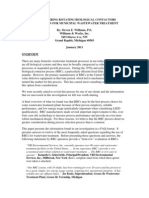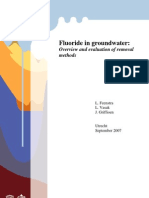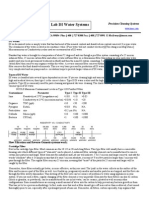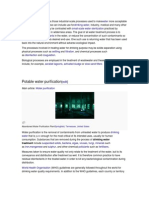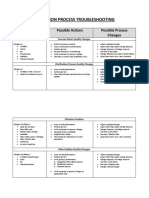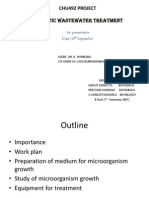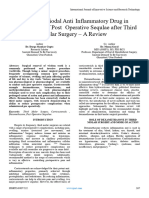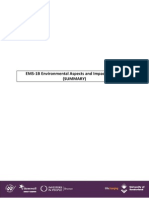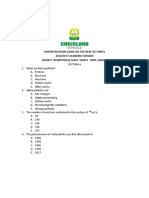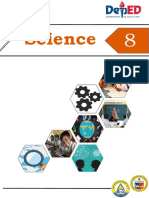Waste Management and Logistics of Craft Beer Production
Waste Management and Logistics of Craft Beer Production
Copyright:
Available Formats
Waste Management and Logistics of Craft Beer Production
Waste Management and Logistics of Craft Beer Production
Copyright
Available Formats
Share this document
Did you find this document useful?
Is this content inappropriate?
Copyright:
Available Formats
Waste Management and Logistics of Craft Beer Production
Waste Management and Logistics of Craft Beer Production
Copyright:
Available Formats
Volume 6, Issue 9, September – 2021 International Journal of Innovative Science and Research Technology
ISSN No:-2456-2165
Waste Management and Logistics of
Craft Beer Production
Attila Albert
Doctoral School on Safety and Security Sciences
Óbudai University
Budapest, Hungary
Abstract:- During small-scale brewing, the energy II. WASTE MANAGEMENT AND RECYCLING IN
demand and the amount of waste generated are very high. THE FOOD INDUSTRY
In order to reduce these quantities, the methods and
materials used in production and their logistics need to be One of the most important tasks of logistics is the
reviewed. Therefore, in my research, I look for the critical storage, transport and disposal of waste generated during
points where most waste is generated and try to find production. The professional, environmentally friendly
alternative methods that help reduce energy demand, collection of materials and waste used in production is the task
waste generated, and transportation costs. I will examine of recycling logistics. CLXXXV of 2012 on waste
what the Life Cycle Assessment and the Carbon Footprint management. The law is in line with the European Union's
are and look for a solution to reduce these metrics. I map environmental policy. This law covers the following activities:
out the possible recycling opportunities that can be used -collection and transport of waste,
in brewing processes, especially the recycling possibilities -waste management,
of wastewater, sludge and yeast. I am also looking at -monitoring of these activities,
alternative waste reduction options for packaging waste, -activity as a trader or intermediary,
as well as ways to reduce the logistical problems and costs -operation of waste management facilities and equipment,
associated with waste management. With this -Aftercare of waste facilities.
information, small-scale brewing will have the
opportunity to create a more sustainable, environmentally The Waste Act imposes the following conditions on
friendly production process. waste management activities:
-the activity must be carried out without endangering human
Keywords:- Craft Beer, Waste Management, Logistics, health and the environment
Sustainability, Recycling. -the activity does not pose a risk to the environmental
elements,
I. INTRODUCTION -do not cause a nuisance or smell to the public,
-does not adversely affect the landscape, protected natural and
Brewing is a high energy process. For the industry to be cultural values.
sustainable, renewable energy sources must be involved in
production. Life Cycle Assessment (LCA) is a method that The concept of waste is most simply formulated as what
allows the environmental impact of a product during its life is not needed, what is unnecessary, what we put in the trash
cycle to be individualized and quantified. As neither small- [2].
scale and large-scale brewing can be described as
environmentally friendly, especially with regard to the The primary goal of the plants is to minimize the amount
resources used, such as water and energy, some sustainable of waste generated during production. The part of the material
practices need to be introduced into the brewing process in used that appears in the finished product is called useful or
order to be sustainable [1]. Carbon Footprint (CF) is an pure use, and its size is specified by the so-called net norm. In
indicator of the total amount of direct and indirect emissions some industries, such as the food industry, a certain amount of
of carbon dioxide (CO2) and other greenhouse gases, raw material in the finished product is an essential condition
expressed in carbon dioxide equivalent (CO2eq). The LCA for the required quality of the product. In these sectors, the
method is often used to calculate this indicator. At present, raw material content of the finished product is usually set by
these indicators are very high in the industry, moreover, in standards. In such cases, the reduction of clean use degrades
terms of the amount produced, the waste and energy used in the quality of the finished product [3]. In the case of small
small-scale production are significantly higher in specific plants, it is even more important to minimize the waste
terms than in large-scale production. In order to reduce these generated, as the cost of waste management per product will
indicators, we need to review production processes and apply be higher for fewer finished products.
new methods that help reduce energy consumption and the
amount of waste generated.
IJISRT21SEP271 www.ijisrt.com 278
Volume 6, Issue 9, September – 2021 International Journal of Innovative Science and Research Technology
ISSN No:-2456-2165
Not only is waste generated in the food industry during Designing local supply chains can save a lot of transportation
production, but a quarter, or even half, of the quantities costs. Breweries have the option of entering into contracts
produced become inedible even before it reaches the with their suppliers that oblige suppliers to take back the
consumer’s mouth. The food industry does not aim to reduce packaging materials in which the raw materials needed for
food waste generated by households, as these increase their production are delivered to the plants. This can significantly
revenues. Although there are campaigns for food waste reduce the waste production of a brewery.
reforms, producers cannot be forced to produce less waste [4].
Solution options: Brewing is divided into several successive operations:
- redistribution: mainly redistribution of remaining, surplus malting, grinding, mashing, copying, adding hops or hop
raw materials to those in need extract and boiling the whey, disposing of used hops and
- creation of animal feed precipitated protein, aerating and cooling the whey,
- anaerobic fermentation fermenting with yeast, removing yeast, conditioning
composting maturation) and packaging. The goal is to convert yeast-
- heat treatment and energy recovery [5]. derived sugars into simple sugars with the help of yeast,
which, when fermented, result in a low-alcohol, lightly
In addition, waste generated during production can be carbonated beverage. This production process leads to the
used more widely, which can even serve as a raw material in generation of large amounts of organic waste [7].
other industries:
1. reuse in the food industry: the resulting by-products can be The principle of prevention is paramount in waste
used to produce another new type of product management. By choosing the right technologies, processes
- flour: the pulverulent material produced during milling could and materials, many wastes can be significantly reduced.
be used as a food supplement by milling plants, as they are Another important task is the selective collection of recyclable
generally of high nutritional value but cannot be used in a or salable waste. The use of a compactor can also reduce
given production process. storage space and shipping costs. Alternatively, the possibility
- colorants: as a natural colorant, food waste can be recovered of energy recovery by incineration can be explored, which
much more valuable, as opposed to synthetic colorants should be preferred to landfill [8]. Amienyo et al. says twelve
- enzymes: enzymes can reduce the chemical load, making environmental impacts were studied in relation to beer
production more sustainable, eliminating toxic substances and packaging, taking into account 3 types of packaging methods,
reducing pollution which are as follows:
2. cosmetics industry: the demand for the use of natural -global warming potential (GWP)
materials has come to the fore in the production of cosmetic - abiotic depletion potential (ADP)
products, so food by-products can be used instead of artificial -acidification potential (AP)
ones - eutrophication potential (EP)
- antioxidant: a very important substance for the human body, - human toxicity potential (HTP)
so it can be easily replaced by recycling waste from the food - marine aquatic ecotoxicity potential (MAETP)
industry. It is especially needed by the skin, so it is often used -natwater aquatic ecotoxicity potential (FAETP)
in sunscreens and oils. - terrestrial ecotoxicity potential (TETP)
3. Pharmaceutical industry: Synthetic antimicrobials, which -zone depletion potential (ODP)
are used against microorganisms in the pharmaceutical - photochemical oxidant generation potential (POCP)
industry, are causing more and more respiratory diseases and energy demand
infections in human organisms. Thus, the pharmaceutical -water demand
industry is also open to using natural substances as raw The 3 types of packaging carriers tested:
materials for medicines. -steel box
- antibacterial and anti-cancer preparations: food by-products -glass
are in many cases a source of excellent nutrients and -aluminum box
phytochemical compounds for a healthy lifestyle.
antivirals: viral mutations have accelerated in recent years, Beer in steel cans has the least impact on five of the 12
leading researchers to move towards bioactive ingredients that impact categories considered: primary energy demand,
have high antiviral capacity, reduce the activity of infected depletion of abiotic resources, acidification, marine and
cells and inhibit their proliferation [6]. freshwater toxicity. Bottled beer is the worst solution for nine
impact categories, including global warming and primary
III. MATERIAL AND METHOD energy demand, but has the least potential for human toxicity.
Beer in aluminum cans is the best solution for ozone depletion
Critical points of waste generation, prevention and recycling and photochemical smog but has the greatest potential for
Waste generation from large-scale breweries is human and marine toxicity [9]. Nevertheless, Molina-Besch et
outstanding in the food sector, mainly due to wastewater. The al. draws attention to the fact that the indirect environmental
energy demand and waste generation of craft breweries is even effects of packaging are not sufficiently taken into account in
higher in specific terms than that of large-scale breweries. In current food LCA practice. A more systematic study of
the interests of sustainability, logistics supply chains, which in indirect environmental effects would be needed to establish a
many cases cross countries and continents, should be replaced more accurate LCA. In addition, further packaging research is
by local supply chains, thus increasing sustainability. needed to obtain the currently missing empirical data [10].
IJISRT21SEP271 www.ijisrt.com 279
Volume 6, Issue 9, September – 2021 International Journal of Innovative Science and Research Technology
ISSN No:-2456-2165
Critical points of the brewing process in terms of waste treated with an outdoor photobioreactor to grow microalgae,
production: and excess sludge was treated with hydrothermal
carbonization. With this system, all organic carbon in
1. Mash, mud wastewater was reduced by 97%. This method has
Barley waste can be used as a carbon source during demonstrated a near-zero waste emission system capable of
fermentation for the cultivation of microbial biomass, for the producing high-quality wastewater, recovering nutrients and
production of microbial enzymes, sugars, proteins, organic carbon into microalgal biomass, and producing energy as
acids, antioxidants and food additives, or simply as an biogas and hydrocarbons [13].
adsorbent for the removal of organic matter from wastewater
and the immobilization of various substances [11]. Barley 4. packaging materials
waste is an excellent source of nutrients for ruminants. Most
Hungarian craft breweries consider this recycling option a (a) glass
priority. The waste generated is resold as animal feed. But By reducing glass breakage in the mining industry, the
there are other uses for it. In addition to being reused as food generation of waste can be significantly reduced. It is also
of animal origin, some of its ingredients may be useful as more environmentally and economically advantageous to use
precursors or carbon sources for food chemicals in microbial the largest possible packaging. Although multi-way glass is
fermentations: much more environmentally friendly, it is much more
(a) dietary and nutritional use expensive from a logistical point of view, but it would
(b) commercial and industrial use of microbial products drastically reduce the cost of packaging material. In cases
o bioethanol production where one-way packaging is unavoidable (eg for hygienic
o lactic acid production reasons) or proves to be more economical than multi-way
o production of xylitol packaging, it is advisable to choose packaging that is
o microbial enzyme production recyclable (eg paper or glass) or biodegradable (eg paper).
o protein hydrolyzate production [11] These usually reduce the cost of disposal and can sometimes
even generate revenue [8].
However, it is worth mentioning that a certain proportion
of the remaining beer can be recovered from the remaining b) alu box
mash with different filtration and centrifugation technologies, An excellent alternative to reducing glass production is
so there will be less loss. aluminum cans, which are showing an increasing trend when
packaging craft beers. The production of aluminum cans
Pyocyanin is a fluorescent phenazine pigment, bright requires more energy than that of glass, but their lower weight
blue in color, synthesized exclusively by approximately 95% allows transport to be optimized. The recycling / reuse of
of Pseudomonas aeruginosa strains. Malt pomace is an bottles should be encouraged by streamlining the transport of
excellent environmentally friendly alternative in the process of empty bottles to breweries [1].
producing pyocyanin in a synthetic medium [12].
c) plastic bottles
2. yeast If in some cases plastic-based one-way packaging is
Yeast is a very valuable feed due to its high protein, unavoidable, it is advisable to strive for uniform (same
vitamin and mineral content. It is also suitable for human material) packaging. If the resulting packaging plastic waste is
consumption, in which case the yeast must be dried. Yeast, made uniform (eg only polyethylene films), there is hope for
both in suspension and in dried form, is a valuable raw its recovery or sale [8].
material in the pharmaceutical and cosmetic industries [8].
Plastic packaging is the least environmentally friendly
3. sewage solution, so it is advisable to avoid this in all cases.
The high COD value of the used diatomaceous earth into
the wastewater must be avoided and due to the suspended d) KEG
solids load. Therefore, it is advisable to recycle diatomaceous Packaging in KEG barrels is one of the most
earth in all cases, which has many possibilities. Conservation, environmentally friendly solutions. The tanks are multi-way,
sterilization, soil improvement, composting, regeneration, so they can be used more than once or a significantly larger
building materials industry. amount of beer can be transported in one container. However,
this requires proper cleaning, which increases the amount of
The chemicals entering the wastewater, which are chemicals used. The adversity of recent years has made us
necessary for sterilization and cleaning, must be neutralized. realize that although KEG is environmentally friendly, there
Pomace and yeast do not enter the wastewater using the are times when the volume of beer sold in KEG barrels drops
appropriate technologies. It is important that the label waste to almost zero, as restaurant and restaurant closures caused by
does not end up in the wastewater, as this is harmful to the the corona virus almost zeroed out KEG sales worldwide.
environment as a suspended matter [8].
(e) alternative options
A zero waste treatment system close to food processing It is important that the storage device into which the beer
wastewater has been developed and studied. Wastewater was enters and travels to the consumer is always clean. This is
treated with an anaerobic membrane bioreactor (AnMBR), especially important for recycled devices such as recyclable
IJISRT21SEP271 www.ijisrt.com 280
Volume 6, Issue 9, September – 2021 International Journal of Innovative Science and Research Technology
ISSN No:-2456-2165
glass or KEG barrels. If not properly washed and cleaned, biorefinery [8]. It is important to note, however, that a
there is a risk of infection. Today, the consumption of tank biorefinery involves a huge investment cost, so it makes sense
beers is becoming more widespread, which means that beer is to bring together several smaller distilleries next to each other
taken directly from the factory to the pubs in huge tanks, and set up the plant together. Installing a biorefinery next to
unpasteurized. Its shelf life is thus greatly reduced, but its breweries would take huge logistical costs off the breweries,
enjoyment value is greatly increased due to the omission of creating much more environmentally friendly and sustainable
heat treatment. To prevent the storage tanks from becoming production, with, of course, greater consideration of
dirty and having to be disinfected weekly, the factories line the environmental impacts.
inside of the tanks with a sterile bag and fill the beer directly
into these bags, thus avoiding contact with metal surfaces. It IV. RESULTS & SUMMARY
can be disposed of after the bag has been emptied, which is
reassuring from a food safety point of view, but a concern In my research, I map out the critical points in the
from an environmental and sustainability point of view. process of artisanal, small-scale beer production from the
point of view of waste management and logistics. In terms of
Waste logistics, alternative, on-site use of waste from waste, there are countless recycling results that are many times
brewing: Algae, Biomass, Biorefinery more economical, environmentally friendly and sustainable
Algae immobilization remains an open field for different instead of the current useful methods. Of course, the principle
research in different fields. Immobilized algae technology has of prevention is the most important, but there are cases where
proven to be very effective in remediation, heavy metal this is not possible. In the case of the packaging of the finished
removal, and toxicity assessment. One of the most promising product, I examined the most sustainable solution, considering
areas of research is the use of this technology to reduce 12 aspects, projected on 3 different packaging materials, but
environmental pollution through the biosorption and each of them also has advantages and disadvantages.
biodegradation of many harmful compounds. Combinations of Alltogether, multi-way, high-capacity, high-fracture, but very
solar energy and algae immobilization technologies can be light glass would be the most environmentally friendly
successfully applied in industrial processes, including brewing packaging materials in the beer industry, but they don’t exist
[14]. yet. An alternative could be to use tank circuits in catering
units, but this is unsuitable for home use. In most cases, the
Brewery wastewater contains huge amounts of organic recyclable food by-products can be recycled. There are
compounds that can cause environmental pollution. The numerous solutions for wastewater treatment, a novelty is the
microalgae wastewater treatment method is an emerging, treatment with an anaerobic membrane bioreactor, which can
environmentally friendly biotechnological process. Microalgae reduce the amount of total organic carbon in the water by
thrive well in nutrient-rich wastewater by absorbing organic 97%. Based on the immobilization of algae, it is an open area,
nutrients and converting them into useful biomass. Harvested carrying it in countless ways. Biomass production and the
biomass can be used as animal feed, biofertilizer and as an establishment of a bioprocessing plant for breweries is a whole
alternative energy source for biodiesel production [15]. new field, but there are many potential rejectors in it. It can
significantly reduce logistics costs, but at a huge investment
There are three main aspects to the success of any cost. The task of the future is to examine the economy and
sustainable biofuel: technical feasibility; economic viability; sustainability of such a factory, considering the environmental
and sustainability of resources. Algae-based biofuels are effects.
technically feasible. In addition, the sustainability of resources
in terms of land, water, nutrient and energy use needs to be REFERENCES
carefully quantified for each type of production system so that
the raw material is truly “sustainable”. With large-scale [1]. A. Baiano, “Craft beer: An overview,” Compr. Rev.
biofuel production processes, this hydropower-nutrient Food Sci. Food Saf., vol. 20, no. 2, pp. 1829–1856,
relationship is the subject of considerable consideration and 2021, doi: 10.1111/1541-4337.12693.
debate [16]. [2]. E. Lendvai, “MEZŐGAZDASÁGI ÉS
ÉLELMISZERIPARI HULLADÉKOK,” pp. 161–170,
Integrating a biorefinery into the production system 2017.
allows high value-added waste to be recycled and prevents it [3]. P. Papp, I. Budai, and L. Porkoládi, “AZ
from being wasted. This makes the process not only ANYAGFELHASZNÁLÁS GAZDASÁGOSSÁGI
economically but also environmentally sustainable, reducing ELEMZÉSE ⊗ ECONOMYCAL ANALYSIS OF
waste generation and resource use. Waste from breweries is an MATERIAL UTILIZATION,” 2011.
excellent raw material for this [17]. [4]. L. E. García Reyes, “Waste and Waste Management,” J.
Chem. Inf. Model., vol. 53, no. 9, pp. 1689–1699, 2013.
With aerobic and anaerobic biological treatment [5]. G. Garcia-Garcia, E. Woolley, S. Rahimifard, J.
processes, biogas and biomass can be generated from the Colwill, R. White, and L. Needham, “A Methodology
waste generated during brewing. There is a very significant for Sustainable Management of Food Waste,” Waste
potential in the operation of block heating power plants with and Biomass Valorization, vol. 8, no. 6, pp. 2209–2227,
biogas. By utilizing in this way, the amount of biogas that can 2017, doi: 10.1007/s12649-016-9720-0.
be produced from the brewery's waste can cover a significant
part of the total energy demand. Biomass would supply a
IJISRT21SEP271 www.ijisrt.com 281
Volume 6, Issue 9, September – 2021 International Journal of Innovative Science and Research Technology
ISSN No:-2456-2165
[6]. L. L. D. R. Osorio, E. Flórez-López, and C. D. Grande-
Tovar, “The Potential of Selected Agri-Food Loss and
Waste to Contribute to a Circular Economy:
Applications in the Food, Cosmetic and Pharmaceutical
Industries,” Molecules, vol. 26, no. 2, 2021, doi:
10.3390/molecules26020515.
[7]. K. Rachwał, A. Waśko, K. Gustaw, and M. Polak-
Berecka, “Utilization of brewery wastes in food
industry,” PeerJ, vol. 8, pp. 1–28, 2020, doi:
10.7717/peerj.9427.
[8]. M. Galli and G. Zilahy, “A tisztább termelés lehet ő
ségei a söriparban,” A Budapesti
Közgazdaságtudományi és Államigazgatási Egy.
Környezettudományi Intézetének tanulmányai, no. 16,
2002.
[9]. D. Amienyo and A. Azapagic, “Life cycle
environmental impacts and costs of beer production and
consumption in the UK,” Int. J. Life Cycle Assess., vol.
21, no. 4, pp. 492–509, 2016, doi: 10.1007/s11367-016-
1028-6.
[10]. K. Molina-Besch, F. Wikström, and H. Williams, “The
environmental impact of packaging in food supply
chains—does life cycle assessment of food provide the
full picture?,” Int. J. Life Cycle Assess., vol. 24, no. 1,
pp. 37–50, 2019, doi: 10.1007/s11367-018-1500-6.
[11]. P. S. Nigam, “An overview: Recycling of solid barley
waste generated as a by-product in distillery and
brewery,” Waste Manag., vol. 62, pp. 255–261, 2017,
doi: 10.1016/j.wasman.2017.02.018.
[12]. B. Teixeira et al., “Craft beer waste as substrate for
pyocyanin synthesis,” vol. 14, no. 1, pp. 21–25, 2019,
doi: 10.9790/3008-1401042125.
[13]. A. D. Grossman et al., “Advanced near-zero waste
treatment of food processing wastewater with water,
carbon, and nutrient recovery,” Sci. Total Environ., vol.
779, p. 146373, 2021, doi:
10.1016/j.scitotenv.2021.146373.
[14]. J. Kaparapu, M. Narasimha, R. Geddada, and M. N.
Rao, “Applications of immobilized algae,” J. Algal
Biomass Utln, vol. 7, no. 72, pp. 122–128, 2016,
[Online]. Available:
http://jalgalbiomass.com/paper3vol7no2.pdf.
[15]. D. K. Amenorfenyo et al., “Microalgae brewery
wastewater treatment: Potentials, benefits and the
challenges,” Int. J. Environ. Res. Public Health, vol. 16,
no. 11, 2019, doi: 10.3390/ijerph16111910.
[16]. A. Juneja, R. M. Ceballos, and G. S. Murthy, “Effects
of environmental factors and nutrient availability on the
biochemical composition of algae for biofuels
production: A review,” Energies, vol. 6, no. 9, pp.
4607–4638, 2013, doi: 10.3390/en6094607.
[17]. S. González-García, P. C. Morales, and B. Gullón,
“Estimating the environmental impacts of a brewery
waste–based biorefinery: Bio-ethanol and
xylooligosaccharides joint production case study,” Ind.
Crops Prod., vol. 123, no. April, pp. 331–340, 2018,
doi: 10.1016/j.indcrop.2018.07.003.
IJISRT21SEP271 www.ijisrt.com 282
You might also like
- AASHTO M 270 Grade Steel PDFDocument14 pagesAASHTO M 270 Grade Steel PDFarunjacobnNo ratings yet
- 105 Converting Coarse Bubble Aeration To Fine BubbleDocument3 pages105 Converting Coarse Bubble Aeration To Fine BubbleLTE002No ratings yet
- Reconsidering Rotating Biological ContactorsDocument11 pagesReconsidering Rotating Biological ContactorsJohn WellardNo ratings yet
- Shortcut Nitrogen Removal-Nitrite Shunt and DeammonificationFrom EverandShortcut Nitrogen Removal-Nitrite Shunt and DeammonificationNo ratings yet
- ChE 145 Post Lab Report - Experiment 1 - Reynolds Number ExperimentDocument9 pagesChE 145 Post Lab Report - Experiment 1 - Reynolds Number ExperimentAnonymous CCNsLVkWqNo ratings yet
- Conventional Wastewater Treatment Process and Operation NAMPAPDocument59 pagesConventional Wastewater Treatment Process and Operation NAMPAPRL SanNo ratings yet
- Gaseous WasteDocument3 pagesGaseous WastezaityzakeryNo ratings yet
- Breweries and Distilleries Effluent ManagementDocument22 pagesBreweries and Distilleries Effluent ManagementAkhil Shetty100% (1)
- Planning and Analysis of Sewage Treatment PlantDocument2 pagesPlanning and Analysis of Sewage Treatment PlantNikhil SachdevaNo ratings yet
- Proposal Tandale 1Document24 pagesProposal Tandale 1Rajabu HatibuNo ratings yet
- Flouride in Ground WaterDocument25 pagesFlouride in Ground WaterrafiluNo ratings yet
- Effluent TreatmentDocument365 pagesEffluent TreatmentMubarik AliNo ratings yet
- Pre-Lab ReportDocument6 pagesPre-Lab ReportTintin Brusola SalenNo ratings yet
- Energy Assessment Checklist Rev Oct09Document4 pagesEnergy Assessment Checklist Rev Oct09Mike FranksNo ratings yet
- BOD ProblemsDocument1 pageBOD ProblemsJustine Kei Lim-OrtegaNo ratings yet
- FAO GIZ GuidelinesDocument140 pagesFAO GIZ GuidelinesMatheus CardimNo ratings yet
- Cost Analysis of Trickling-FiltrationDocument15 pagesCost Analysis of Trickling-FiltrationnawajhaNo ratings yet
- HB 224-2001 Handbook For Microbiological Testing in Food PremisesDocument6 pagesHB 224-2001 Handbook For Microbiological Testing in Food PremisesSAI Global - APAC0% (1)
- Assignment Tutorial WWWDocument5 pagesAssignment Tutorial WWWZariq NazaruddinNo ratings yet
- Lab Waste WaterDocument10 pagesLab Waste WaterAriffNo ratings yet
- Group 1 - Section 01G - Separation Project PDFDocument46 pagesGroup 1 - Section 01G - Separation Project PDFHatta AimanNo ratings yet
- Lab DI Water SystemsDocument6 pagesLab DI Water SystemsHaidee Che RizminNo ratings yet
- Lec 4 - Aerated Lagoons & Secondary Clarifier (Compatibility Mode)Document7 pagesLec 4 - Aerated Lagoons & Secondary Clarifier (Compatibility Mode)Muhammad FarhanNo ratings yet
- Aeration System in WWTPDocument10 pagesAeration System in WWTPashokNo ratings yet
- Recomended Design Criteria Manual - Wastewater Collection and Treatment FacilitiesDocument139 pagesRecomended Design Criteria Manual - Wastewater Collection and Treatment FacilitiesCarlos VegaNo ratings yet
- Review On VOC RemovalDocument18 pagesReview On VOC RemovalMuhammad Shehzad Kamal100% (1)
- Biogas From Textile Cotton Waste PDFDocument5 pagesBiogas From Textile Cotton Waste PDFSakthi GaneshNo ratings yet
- Potable Water Purification: Water Treatment Describes Those Industrial-Scale Processes Used To MakeDocument7 pagesPotable Water Purification: Water Treatment Describes Those Industrial-Scale Processes Used To MakeKay RenNo ratings yet
- Advocacy EssayDocument8 pagesAdvocacy EssaySamantha SinghaNo ratings yet
- Grey Water Treatment Using Different Design of Sand FilterDocument8 pagesGrey Water Treatment Using Different Design of Sand FilterHasnanurfajriahNo ratings yet
- 160 0004 Ozone NewDocument4 pages160 0004 Ozone NewRafael Lino De SousaNo ratings yet
- Water Treatment Plant PCE 455 Group OneDocument24 pagesWater Treatment Plant PCE 455 Group OnekhemyNo ratings yet
- Nassau Sewer System RFI VFDocument56 pagesNassau Sewer System RFI VFNewsdayNo ratings yet
- Solid Waste Management Practices in Selected Food Service Establishments in Talisay City, Negros Island Region, PhilippinesDocument5 pagesSolid Waste Management Practices in Selected Food Service Establishments in Talisay City, Negros Island Region, PhilippinesesatjournalsNo ratings yet
- Drinking Water - SpecificationDocument24 pagesDrinking Water - SpecificationAmanjit SinghNo ratings yet
- 6Document30 pages6Aisar AmireeNo ratings yet
- 631 Progress On Wastewater Treatment 2018Document40 pages631 Progress On Wastewater Treatment 2018hdsNo ratings yet
- Cost Analysis of Activated Sludge ProcessDocument19 pagesCost Analysis of Activated Sludge ProcessDevendra Sharma100% (1)
- Fundamentals of Biological Wastewater Treatment - PrefaceDocument4 pagesFundamentals of Biological Wastewater Treatment - Prefaceabhi_nddNo ratings yet
- Passavant E&E Company Profile-4th QTRDocument77 pagesPassavant E&E Company Profile-4th QTRSami Sawalha100% (1)
- 5.3. Municipal Solid Waste - Waste Characterization StudyDocument11 pages5.3. Municipal Solid Waste - Waste Characterization StudyAnimesh Banerjee0% (1)
- Filtration Process TroubleshootingDocument2 pagesFiltration Process TroubleshootingFirdaus Yahya100% (1)
- WATERGY - Energy and Water EfficiencyDocument142 pagesWATERGY - Energy and Water EfficiencyJohn BandaNo ratings yet
- Case Study Number 3Document11 pagesCase Study Number 3Patrisha Marie Iya BautistaNo ratings yet
- Domestic Waste Water Treatment PPDocument9 pagesDomestic Waste Water Treatment PPPreetam Godbole100% (1)
- 5 Threats To Chiller EfficiencyDocument57 pages5 Threats To Chiller EfficiencyOcta RioNo ratings yet
- Cylinder Valve Inlet TypeDocument2 pagesCylinder Valve Inlet TypeGore JiangNo ratings yet
- About Sewage Treatment PlantDocument47 pagesAbout Sewage Treatment PlantShumank SrivastavaNo ratings yet
- 11 Momentum TransferDocument10 pages11 Momentum TransferJohn Bryan AldovinoNo ratings yet
- Design Consideration of A Plastic Shredder in Recycling ProcessesDocument4 pagesDesign Consideration of A Plastic Shredder in Recycling ProcessesJoel Guillen IparraguirreNo ratings yet
- Start Up & Field Check-Out Procedures Manual SWPADocument32 pagesStart Up & Field Check-Out Procedures Manual SWPARicardo BarrosNo ratings yet
- Lec 8 NeutralizationDocument32 pagesLec 8 Neutralizationhaseeb tahirNo ratings yet
- AMIRAULT Et Al 2003 Activated Carbon Treatment of Drinking Water Supplies PDFDocument4 pagesAMIRAULT Et Al 2003 Activated Carbon Treatment of Drinking Water Supplies PDFTatiana AcostaNo ratings yet
- Energy Valorization of Biogas in Santa CatarinaDocument10 pagesEnergy Valorization of Biogas in Santa CatarinagrimdorlfNo ratings yet
- THESIS 2 Chapter 1 To 3Document89 pagesTHESIS 2 Chapter 1 To 3jolo ranadaNo ratings yet
- Treatment of Softdrink Industry Wastewater Using An Integrated Anaerobicaerobic Membrane BioreactorDocument154 pagesTreatment of Softdrink Industry Wastewater Using An Integrated Anaerobicaerobic Membrane BioreactorAbiodun Gbenga100% (1)
- Design of Wastewater and Stormwater Pumping Stations MOP FD-4, 3rd EditionFrom EverandDesign of Wastewater and Stormwater Pumping Stations MOP FD-4, 3rd EditionRating: 5 out of 5 stars5/5 (1)
- Forging Partnerships Among Water and Wastewater OperatorsFrom EverandForging Partnerships Among Water and Wastewater OperatorsNo ratings yet
- Forest Product Conversion FactorsFrom EverandForest Product Conversion FactorsNo ratings yet
- An Observational Study Homoeopathic Medicines in LM Potency for Treating LeucorrhoeaDocument11 pagesAn Observational Study Homoeopathic Medicines in LM Potency for Treating LeucorrhoeaInternational Journal of Innovative Science and Research TechnologyNo ratings yet
- Bizz Spot: Revolutionizing Small-Scale Industry through Financial Collaboration and Location IntelligenceDocument19 pagesBizz Spot: Revolutionizing Small-Scale Industry through Financial Collaboration and Location IntelligenceInternational Journal of Innovative Science and Research TechnologyNo ratings yet
- Comprehensive Survey on E-Commerce and BlockchainDocument7 pagesComprehensive Survey on E-Commerce and BlockchainInternational Journal of Innovative Science and Research TechnologyNo ratings yet
- Role of Steriodal Anti-Inflammatory Drug in Management of Post -Operative Sequlae after Third Molar Surgery – A ReviewDocument5 pagesRole of Steriodal Anti-Inflammatory Drug in Management of Post -Operative Sequlae after Third Molar Surgery – A ReviewInternational Journal of Innovative Science and Research TechnologyNo ratings yet
- Tinospora Cordifolia and Pterocarpus Marsupium: An Anti-Diabetic Plant with MultipurposeDocument11 pagesTinospora Cordifolia and Pterocarpus Marsupium: An Anti-Diabetic Plant with MultipurposeInternational Journal of Innovative Science and Research TechnologyNo ratings yet
- Comparative Evaluation of Microcrack Formation by K Files Using Mechanical Technique with Help of Reciprocating Contra-Angle Handpiece and Manual Technique: An Invitro StudyDocument7 pagesComparative Evaluation of Microcrack Formation by K Files Using Mechanical Technique with Help of Reciprocating Contra-Angle Handpiece and Manual Technique: An Invitro StudyInternational Journal of Innovative Science and Research TechnologyNo ratings yet
- Natural Conditions for Tourism Development in the Upper Drainage Area of the Rakitnica RiverDocument16 pagesNatural Conditions for Tourism Development in the Upper Drainage Area of the Rakitnica RiverInternational Journal of Innovative Science and Research TechnologyNo ratings yet
- An Experimental Study on Concrete Strength Optimization with Surkhi as an Eco-Friendly Sand SubstituteDocument13 pagesAn Experimental Study on Concrete Strength Optimization with Surkhi as an Eco-Friendly Sand SubstituteInternational Journal of Innovative Science and Research TechnologyNo ratings yet
- Security Risks and Threats in Cloud Computing: A Comprehensive AnalysisDocument6 pagesSecurity Risks and Threats in Cloud Computing: A Comprehensive AnalysisInternational Journal of Innovative Science and Research TechnologyNo ratings yet
- Fetal Health Classification and Birth Weight Estimation Using Machine LearningDocument7 pagesFetal Health Classification and Birth Weight Estimation Using Machine LearningInternational Journal of Innovative Science and Research TechnologyNo ratings yet
- Socio-Economic Benefits of Machine Learning Deployment Platforms in Business: A Case Study of Baseten and Similar ModelsDocument6 pagesSocio-Economic Benefits of Machine Learning Deployment Platforms in Business: A Case Study of Baseten and Similar ModelsInternational Journal of Innovative Science and Research TechnologyNo ratings yet
- Effectiveness of Teachers Training Program in Enhancing Teaching Competence of Public Primary School Teachers in Ilemela Municipality, TanzaniaDocument11 pagesEffectiveness of Teachers Training Program in Enhancing Teaching Competence of Public Primary School Teachers in Ilemela Municipality, TanzaniaInternational Journal of Innovative Science and Research TechnologyNo ratings yet
- Assess Resilience Behavior with Interpersonal Relationship among Faculties - A Correlational StudyDocument5 pagesAssess Resilience Behavior with Interpersonal Relationship among Faculties - A Correlational StudyInternational Journal of Innovative Science and Research TechnologyNo ratings yet
- Maternal Mental Health: Addressing Postpartum Depression and Anxiety in Different Socioeconomic ContextsDocument4 pagesMaternal Mental Health: Addressing Postpartum Depression and Anxiety in Different Socioeconomic ContextsInternational Journal of Innovative Science and Research TechnologyNo ratings yet
- Innovative TiO2 Photocatalysts: Advances and Strategies for Enhanced Hydrogen Evolution EfficiencyDocument18 pagesInnovative TiO2 Photocatalysts: Advances and Strategies for Enhanced Hydrogen Evolution EfficiencyInternational Journal of Innovative Science and Research TechnologyNo ratings yet
- Impact of Temperature and Shading on Performance of Solar Photovoltaic Systems in Telecom SitesDocument11 pagesImpact of Temperature and Shading on Performance of Solar Photovoltaic Systems in Telecom SitesInternational Journal of Innovative Science and Research TechnologyNo ratings yet
- Maintaining Integrity and Confidentiality of Patients’ Records Using an Enhanced Security TechniqueDocument7 pagesMaintaining Integrity and Confidentiality of Patients’ Records Using an Enhanced Security TechniqueInternational Journal of Innovative Science and Research TechnologyNo ratings yet
- Classification of the Penguluran River and Mbambang River using Macroinvertebrate with TWINSPAN AnalysisDocument6 pagesClassification of the Penguluran River and Mbambang River using Macroinvertebrate with TWINSPAN AnalysisInternational Journal of Innovative Science and Research TechnologyNo ratings yet
- Discovery of a Stone Circle (Cairn Circle) at Sree Krishna College Guruvayur: A Link to South India’s Stone Age HeritageDocument5 pagesDiscovery of a Stone Circle (Cairn Circle) at Sree Krishna College Guruvayur: A Link to South India’s Stone Age HeritageInternational Journal of Innovative Science and Research TechnologyNo ratings yet
- Effect of Sporosarcina Pasteurii on Rheological and Strength Properties of Bio-Self Compacting ConcreteDocument12 pagesEffect of Sporosarcina Pasteurii on Rheological and Strength Properties of Bio-Self Compacting ConcreteInternational Journal of Innovative Science and Research TechnologyNo ratings yet
- Neuro Fuzzy in Predicting the Characteristics of Some NanomaterialsDocument6 pagesNeuro Fuzzy in Predicting the Characteristics of Some NanomaterialsInternational Journal of Innovative Science and Research TechnologyNo ratings yet
- Operational Management Practices of Resorts in Dinadiawan, Dipaculao, Aurora: A Basis for Strategic PlanDocument33 pagesOperational Management Practices of Resorts in Dinadiawan, Dipaculao, Aurora: A Basis for Strategic PlanInternational Journal of Innovative Science and Research TechnologyNo ratings yet
- Integrating Blockchain and Homomorphic Encryption to Enhance Security and Privacy in Project Management and Combat Counterfeit Goods in Global Supply Chain OperationsDocument22 pagesIntegrating Blockchain and Homomorphic Encryption to Enhance Security and Privacy in Project Management and Combat Counterfeit Goods in Global Supply Chain OperationsInternational Journal of Innovative Science and Research TechnologyNo ratings yet
- A Study of Various Clustering Algorithms Used for Radar Signal SortingDocument12 pagesA Study of Various Clustering Algorithms Used for Radar Signal SortingInternational Journal of Innovative Science and Research Technology100% (1)
- Balancing Safety and Justice, the Ethics of Predictive PolicingDocument9 pagesBalancing Safety and Justice, the Ethics of Predictive PolicingInternational Journal of Innovative Science and Research TechnologyNo ratings yet
- An Analysis of the Potential Benefits of Play-Based Methods for Improving Learning in Children with AutismDocument6 pagesAn Analysis of the Potential Benefits of Play-Based Methods for Improving Learning in Children with AutismInternational Journal of Innovative Science and Research TechnologyNo ratings yet
- IBM MDM 11.6 Installation: Topology, Software Bundles, Prerequisites, Steps and IssuesDocument5 pagesIBM MDM 11.6 Installation: Topology, Software Bundles, Prerequisites, Steps and IssuesInternational Journal of Innovative Science and Research TechnologyNo ratings yet
- Feasibility Testing of Digitise Home Visit Service(DHVS) Core ModelDocument6 pagesFeasibility Testing of Digitise Home Visit Service(DHVS) Core ModelInternational Journal of Innovative Science and Research TechnologyNo ratings yet
- Optimization of Quadcopter Propeller Aerodynamics Using Blade Element and Vortex TheoryDocument49 pagesOptimization of Quadcopter Propeller Aerodynamics Using Blade Element and Vortex TheoryInternational Journal of Innovative Science and Research TechnologyNo ratings yet
- Predictive Analytics in ADAS Development: Leveraging CRM Data for Customer-Centric Innovations in Car ManufacturingDocument6 pagesPredictive Analytics in ADAS Development: Leveraging CRM Data for Customer-Centric Innovations in Car ManufacturingInternational Journal of Innovative Science and Research TechnologyNo ratings yet
- Physical ScienceDocument60 pagesPhysical SciencePaul Kenneth Nuñez CorotNo ratings yet
- FogDocument307 pagesFogmshamil100% (1)
- Microplásticos - Un Contaminante Que Crece en Todas Las Esferas Ambientales, SusDocument20 pagesMicroplásticos - Un Contaminante Que Crece en Todas Las Esferas Ambientales, SusBetoNo ratings yet
- Earth & Life Science: Quarter 1 - Module 1 Uniqueness of EarthDocument14 pagesEarth & Life Science: Quarter 1 - Module 1 Uniqueness of Earthjude christopherNo ratings yet
- Rac Lab MANUALDocument14 pagesRac Lab MANUALgotu123No ratings yet
- DPP (For Vacation)Document2 pagesDPP (For Vacation)dharmesh kumarNo ratings yet
- A Detailed Lesson Plan in Science 9 JANUARY 15, 2019Document8 pagesA Detailed Lesson Plan in Science 9 JANUARY 15, 2019Shiela Mae OsmanNo ratings yet
- Cangel & Boles TranslateDocument16 pagesCangel & Boles TranslateRidho Dwi SyahrialNo ratings yet
- Mita Lifestyle Agenda ContentDocument263 pagesMita Lifestyle Agenda Contentnacentral13517No ratings yet
- Value Chain of PLN GG Dalam Proses Bisnis PLN: WWW - Pln.co - IdDocument2 pagesValue Chain of PLN GG Dalam Proses Bisnis PLN: WWW - Pln.co - IdDarwin HudeNo ratings yet
- 5.7 Cell TransportDocument6 pages5.7 Cell TransportMonica B. BautistaNo ratings yet
- Physics 534 Chapter 8Document19 pagesPhysics 534 Chapter 8neilmacintoshNo ratings yet
- Multiverse Theory PPT Presentation by Meraal Aamir1230Document10 pagesMultiverse Theory PPT Presentation by Meraal Aamir1230meraalaamirNo ratings yet
- Notes About ElementsDocument4 pagesNotes About ElementsJethro ngoNo ratings yet
- G8 Worksheet Q3 W1Document10 pagesG8 Worksheet Q3 W1SARAH MAY DELA CRUZNo ratings yet
- Komparasi Marshall Campuran AC-WCDocument14 pagesKomparasi Marshall Campuran AC-WCfalikhatul01No ratings yet
- Mrunal (GS3) Clean Energy - Floating Solar Plants, Agnisumukh LPGDocument8 pagesMrunal (GS3) Clean Energy - Floating Solar Plants, Agnisumukh LPGtareshNo ratings yet
- The Emergence of Environmental IssuesDocument17 pagesThe Emergence of Environmental IssuesAditi MattaNo ratings yet
- EMS-1B Environmental Aspects and Impacts Register (Summary)Document12 pagesEMS-1B Environmental Aspects and Impacts Register (Summary)ezal2No ratings yet
- Power To Change, Pembina InstituteDocument28 pagesPower To Change, Pembina InstituteCalgary HeraldNo ratings yet
- Mawrai Aloom Ka KhulasaDocument46 pagesMawrai Aloom Ka Khulasabilly_1990No ratings yet
- Pipeline Stability: Jona JohariDocument60 pagesPipeline Stability: Jona JohariandrairawanNo ratings yet
- Yr 9 Physics Revision 2Document5 pagesYr 9 Physics Revision 2KitanNo ratings yet
- Incident Investigadetion: Incident Cause Analysis Method (ICAM)Document11 pagesIncident Investigadetion: Incident Cause Analysis Method (ICAM)John LawingNo ratings yet
- What Is A Gyroscope?Document18 pagesWhat Is A Gyroscope?Famous GuyNo ratings yet
- IGCSE BIOLOGY/O-level: Test OnDocument10 pagesIGCSE BIOLOGY/O-level: Test OnKazi AdyanNo ratings yet
- EE201 Notes 1 Introduction To SemiconductorDocument18 pagesEE201 Notes 1 Introduction To SemiconductoradamwaizNo ratings yet
- ScienceDocument15 pagesScienceJezz Betiz VergaraNo ratings yet
- Rediscovering Zaev's Ferro-Kessor: History NotesDocument12 pagesRediscovering Zaev's Ferro-Kessor: History NotesNguyen PhongNo ratings yet


